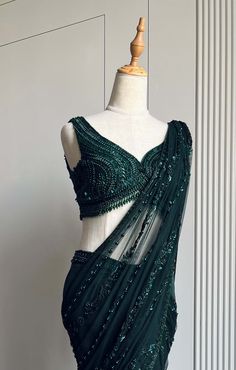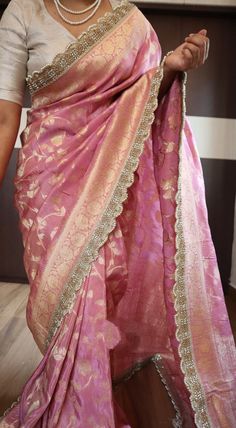The Indian saree is a quintessential garment that exemplifies elegance, tradition, and cultural heritage. Worn by women across India and increasingly celebrated globally, the saree represents a harmonious blend of craftsmanship, textile diversity, and regional aesthetics. This class note delves into the art of Indian saree design within the context of fashion design, exploring its history, construction techniques, regional variations, contemporary adaptations, and its significance as a cultural icon.

1. Historical and Cultural Significance
The saree holds immense cultural significance in India, with a rich history that spans centuries:
- Origins: The origin of the saree dates back to ancient times, evolving from unstitched garments draped around the body. It has been mentioned in ancient texts and depicted in sculptures, highlighting its enduring legacy.
- Symbolism: Beyond its practical use as clothing, the saree symbolizes tradition, femininity, grace, and regional identity. Different regions of India have distinct styles of draping and weaving techniques that reflect local customs and beliefs.
- Evolution: Over time, the saree has evolved in design, materials, and styling, adapting to changing fashion trends while retaining its cultural essence.
Understanding the historical and cultural roots of the saree provides a foundation for appreciating its design intricacies and artistic expressions.
2. Construction and Draping Techniques
The saree’s construction involves several key elements that contribute to its unique charm and versatility:

- Fabric: Sarees are crafted from a wide range of fabrics, including silk, cotton, chiffon, georgette, and more. Each fabric offers distinct textures, drape, and sheen, influencing the saree’s overall look and feel.
- Weaving Techniques: Various weaving techniques such as Banarasi, Kanjeevaram, Paithani, Chanderi, and Jamdani contribute to intricate patterns, motifs, and embellishments woven into the fabric.
- Embroidery and Embellishments: Hand embroidery techniques like zari (metallic thread), zardozi, gota patti, sequins, and beadwork add luxurious detailing and enhance the aesthetic appeal of the saree.
- Draping Styles: The saree can be draped in numerous styles across India, each style showcasing regional preferences and cultural diversity. Common draping styles include Nivi, Bengali, Gujarati, Maharashtrian, and Tamilian, among others.
Mastering the construction and draping techniques allows designers to innovate while honoring traditional craftsmanship.
3. Regional Variations and Styles
India’s diverse cultural landscape gives rise to a multitude of regional saree styles, each distinguished by its weaving techniques, motifs, colors, and draping traditions:

- Banarasi Saree: Originating from Varanasi, Uttar Pradesh, Banarasi sarees are renowned for their intricate brocade work, floral motifs, and heavy zari borders.
- Kanjeevaram Saree: Hailing from Tamil Nadu, Kanjeevaram sarees are characterized by rich silk fabric, contrasting borders, and temple-inspired motifs woven with gold or silver zari.
- Bandhani Saree: Originating from Rajasthan and Gujarat, Bandhani sarees feature tie-dye techniques that create vibrant patterns and designs on lightweight fabrics like chiffon or silk.
- Paithani Saree: Native to Maharashtra, Paithani sarees are known for their peacock and lotus motifs, intricate pallu designs, and the use of pure silk and metallic threads.
- Sambalpuri Saree: From Odisha, Sambalpuri sarees showcase ikat weaving techniques, creating geometric or floral patterns in vibrant colors on silk or cotton fabric.
Exploring these regional variations inspires designers to incorporate diverse elements into their saree designs, celebrating India’s cultural mosaic.
4. Contemporary Adaptations and Trends
In contemporary fashion, the saree has undergone various reinterpretations and adaptations to appeal to modern sensibilities:
- Fusion Sarees: Combining elements of Western and Indian attire, fusion sarees feature innovative draping styles, modern silhouettes, and unconventional fabric choices.
- Digital Prints: Digital printing technology allows for intricate designs, motifs, and patterns to be reproduced on sarees, offering versatility and customization options.
- Minimalist Designs: Emphasizing simplicity and clean lines, minimalist sarees appeal to those seeking understated elegance and modern sophistication.
- Global Influence: Saree designers often draw inspiration from international fashion trends, incorporating contemporary elements while preserving traditional craftsmanship.
Contemporary saree design embraces diversity, catering to a global audience while preserving the saree’s timeless appeal.

5. Design Process and Inspirations
Designing a saree involves a creative process that blends cultural influences with personal expression:
- Research and Concept Development: Conduct research on traditional motifs, weaving techniques, and draping styles to inform your design concept.
- Sketching and Visualization: Create preliminary sketches to explore design ideas, silhouette options, and embellishment placements.
- Fabric Selection: Choose fabrics that align with your design vision, considering texture, color, and drape qualities that enhance the saree’s aesthetic appeal.
- Embroidery and Detailing: Collaborate with skilled artisans to incorporate intricate embroidery, embellishments, and handcrafted details that elevate the saree’s craftsmanship.
- Fitting and Finalization: Conduct fittings to ensure the saree drapes elegantly and comfortably, making adjustments as necessary to achieve a perfect fit.
Throughout the design process, draw inspiration from art, culture, nature, architecture, and contemporary trends to infuse creativity into your saree designs.
6. Market Opportunities and Challenges
Saree design presents opportunities and challenges within the global fashion industry:
- Market Demand: The growing popularity of ethnic wear and cultural appreciation drives demand for beautifully crafted sarees worldwide.
- Competition: Navigate competition by offering unique design perspectives, quality craftsmanship, and personalized customer experiences.
- Sustainability: Embrace sustainable practices in sourcing fabrics, production techniques, and business operations to meet consumer expectations for ethical fashion.
- Innovation: Continuously innovate through design experimentation, technological advancements, and collaborative partnerships to stay relevant in a competitive market.
By addressing these opportunities and challenges, saree designers can carve a niche and contribute to the evolution of Indian fashion on a global scale.

7. Conclusion
Indian saree design epitomizes the union of heritage, craftsmanship, and contemporary creativity in fashion. From its historical roots and regional variations to contemporary adaptations and market dynamics, saree design reflects India’s cultural diversity and artistic prowess. Aspiring saree designers are encouraged to explore traditional techniques, embrace innovation, and honor cultural narratives to create timeless pieces that resonate with global audiences.
By celebrating the saree’s legacy while embracing modern influences, designers can contribute to the enduring allure and relevance of this iconic garment in the evolving landscape of fashion design.

